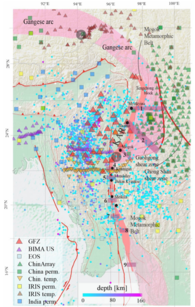CoSuMY - Collision-Subduction Transition in Myanmar-Yunnan
Indent corners in collision zones – syntaxes – are fascinating features in continental tectonics. Deformation is 3D, involving crustal thickening, lateral material flow, and transitions from continental collision to oceanic subduction. The latter can nucleate slab-dynamic processes like slab tearing and break-off. These large-scale processes are showcased best in the India-Asia collision zone, in particular around its eastern corner where India, Myanmar and China meet. Between 2019 and 2021 we operated a 30-station seismic network in northern Myanmar as a basis to study the seismotectonics and structure of the Eastern Himalayan syntaxis and Burma subduction-collision zone. The Project is funded by DFG as part of the CoSuMY - Collision-Subduction Transition in Myanmar-Yunnan – in cooperation with Section 2.4 (Frederik Tilmann and Xiaohui Yuan) and Lothar Ratschbacher Bergakademie TU Freiberg and Sofia Kufner at Karlsruhe Institute of Technology.
PLS: Dr. Bernd Schurr (Sektion 4.1), Prof. Frederik Tilmann (Sektion 2.4), Dr. Xiaohui Yuan (Sektion 2.4)
Publications
Min, M., Ratschbacher, L., Franz, L., Hacker, B. R., Enkelmann, E., Toreno, E. Y., Härtel, B., Schurr, B., Tichomirowa, M., & Pfänder, J. A. (2022). India (Tethyan Himalaya Series) in Central Myanmar: Implications for the Evolution of the Eastern Himalayan Syntaxis and the Sagaing Transform‐Fault System. Geophysical Research Letters, 49(12), 1–10. https://doi.org/10.1029/2022GL099140

